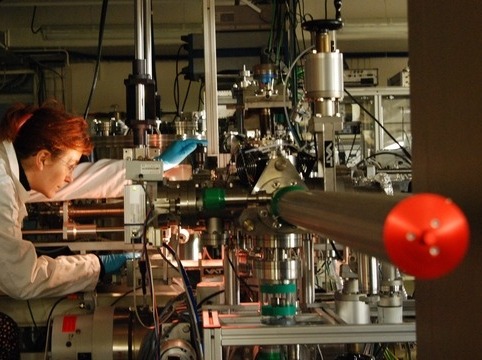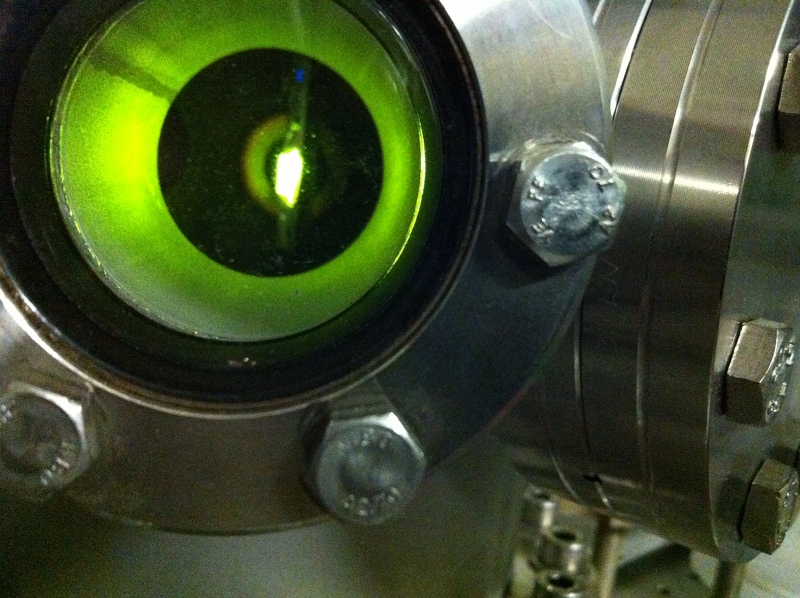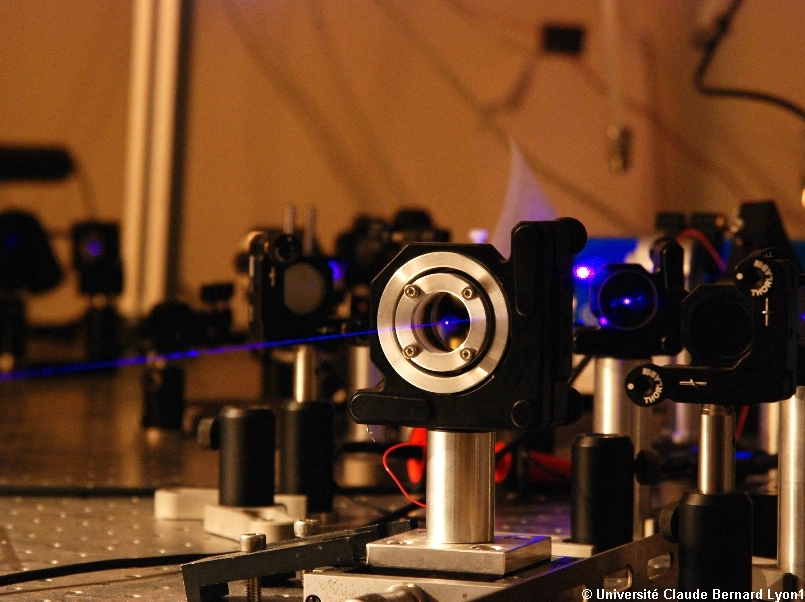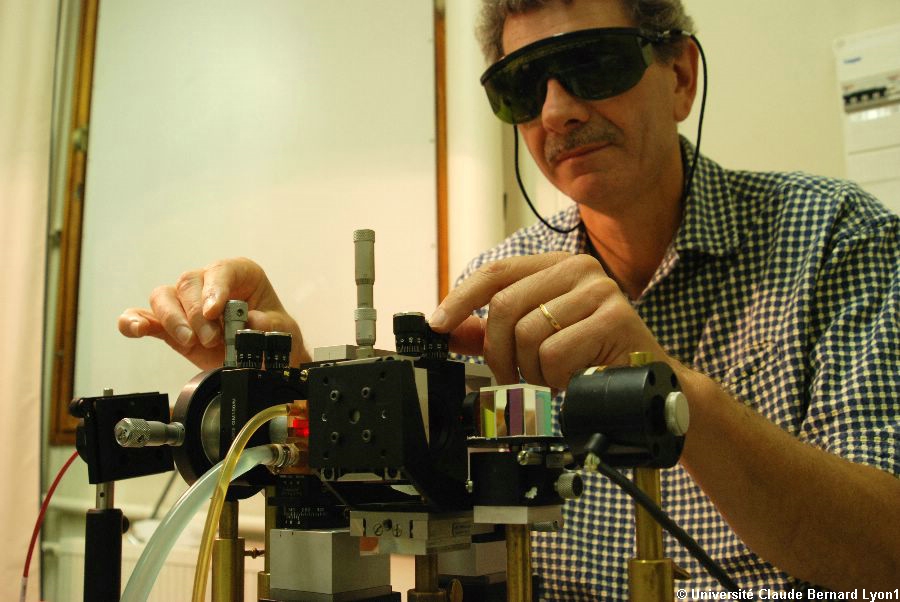MATERIAUX, ENERGIE, PHOTONIQUE
 |
 |
 |
Animateur scientifique : Christophe DUJARDIN
Equipes associées :
- SOPRANO
- FemtoNanoOptics
- (nano)Matériaux pour l'énergie
- Matériaux et nanostructures photoniques
- Nanostructures magnétiques
- Luminescence
 L’axe "Matériaux, Energie, Photonique" trouve sa place entre science fondamentale des matériaux et applications. Il fédère huit équipes dont une part des activités se retrouve dans des thématiques autour de la compréhension de phénomènes physiques en lien avec leurs propriétés structurales ou physico-chimiques, et/ou des applications potentielles de ces mêmes propriétés.
L’axe "Matériaux, Energie, Photonique" trouve sa place entre science fondamentale des matériaux et applications. Il fédère huit équipes dont une part des activités se retrouve dans des thématiques autour de la compréhension de phénomènes physiques en lien avec leurs propriétés structurales ou physico-chimiques, et/ou des applications potentielles de ces mêmes propriétés.
Les frontières du thème matériaux fonctionnels sont délicates à définir. Du point de vue des thèmes scientifiques, la notion de matériaux sous entend que les objets d’intérêt vont des échelles macroscopiques (massifs) à la nano-structure, qu’ils soient amorphes ou cristallins, en passant par des structures mono ou bi-dimentionnelles telles que les fibres ou films minces. On se limitera ici à l’assemblée de nanostructures alors que les études sur particules uniques se retrouveront plus naturellement dans l’axe nano-matériaux, nanooptique et nanoscience.
Du point de vue des fonctions, les équipes sont majoritairement impliquées dans les domaines de l’optique et la spectroscopie. Il en résulte un fort potentiel de compétences et d’équipements pour développer des activités autour des matériaux pour l’optique, qu’ils soient passifs ou actifs. A titre d’illustrations non exhaustives, les propriétés de conversion de fréquences, d’amplification, d’effets Raman stimulés, de scintillation concernent des secteurs d’activités aux enjeux sociétaux importants tels que le photovoltaïque, l’imagerie médicale, les télécommunications, l’opto-électronique, le stockage des déchets nucléaires, la thérapie, la photocatalyse, les bio-capteurs énantiosélectifs… Par ailleurs, la recherche de matériaux à propriétés magnétiques ajustables telles que l’anisotropie magnétique ainsi que les effets des hautes pressions sur la structure et donc les propriétés vibrationnelles, thermoélectriques ou bien supraconductrices font partie des compétences fortes de l’axe matériaux fonctionnels et optique des matériaux.
 Au delà des études de leurs propriétés, l’élaboration de ces matériaux est une des richesses de l’axe. En ce qui concerne l’élaboration de nanoparticules, on retrouvera ainsi plusieurs types de compétences fortes allant de la synthèse par chimie douce de matériaux hybrides à fonctionnalités optiques et magnétiques en direction par exemple de la santé, à des techniques d’élaboration par voies physique (Low Energy Cluster Beam Deposition, Pulsed Laser Ablation in Liquid) pour des études plus fondamentales orientées également vers l’optique ou le magnétisme. Un fort potentiel d’élaboration de films minces à fonctionnalités optiques est également présent à travers les techniques de Pulsed Laser Deposition de dépôts par voies sol-gel de matériaux organiques ou inorganiques. La synthèse cristalline sous forme de fibres ou monocristaux est aussi une compétence importante présente au sein de l’axe. Enfin, l’élaboration de matériaux sous conditions extrêmes de température et pression fait également partie des savoir-faire présents dans l’axe thématique.
Au delà des études de leurs propriétés, l’élaboration de ces matériaux est une des richesses de l’axe. En ce qui concerne l’élaboration de nanoparticules, on retrouvera ainsi plusieurs types de compétences fortes allant de la synthèse par chimie douce de matériaux hybrides à fonctionnalités optiques et magnétiques en direction par exemple de la santé, à des techniques d’élaboration par voies physique (Low Energy Cluster Beam Deposition, Pulsed Laser Ablation in Liquid) pour des études plus fondamentales orientées également vers l’optique ou le magnétisme. Un fort potentiel d’élaboration de films minces à fonctionnalités optiques est également présent à travers les techniques de Pulsed Laser Deposition de dépôts par voies sol-gel de matériaux organiques ou inorganiques. La synthèse cristalline sous forme de fibres ou monocristaux est aussi une compétence importante présente au sein de l’axe. Enfin, l’élaboration de matériaux sous conditions extrêmes de température et pression fait également partie des savoir-faire présents dans l’axe thématique.
Une grande partie de ces thèmes de recherche s’appuie sur les plateformes de l’institut (CECOMO, PLYRA, NanOptec, PLECE, Nano-Hybride& Bio, CML) et hors instituts (CLYM, Cristal INNOV) ainsi que sur les grands instruments, l’ESRF, l’ILL et Soleil au niveau national, DESY, BESSY (Allemagne), SLS (Suiisse), ELETRA (Italie) Argone (USA) et Campesina (Brésil) au niveau international.
MATERIALS, ENERGY, PHOTONICS
 |
 |
 |
Scientific Coordinator: Christophe DUJARDIN
Associated Research teams:
- SOPRANO
- FemtoNanoOptics
- (nano)Matériaux pour l'énergie
- Matériaux et nanostructures photoniques
- Nanostructures magnétiques
- Luminescence
 The axis “Materials, Energy, Photonics” occupies the middle ground between fundamental materials science and application-oriented research. It unites eight groups whose research activities contain an aspect of understanding physical phenomena with respect to the structural or physico-chemical properties of materials and/or the potential applications of those same properties.
The axis “Materials, Energy, Photonics” occupies the middle ground between fundamental materials science and application-oriented research. It unites eight groups whose research activities contain an aspect of understanding physical phenomena with respect to the structural or physico-chemical properties of materials and/or the potential applications of those same properties.
The boundaries of the functional materials domain are difficult to define sharply. With respect to scientific questions, the concept of “materials” implies that the dimensions of the objects of interest range from the macroscopic (bulk materials) down to nanostructures, both amorphous and crystalline, with one- or two-dimensional structures, e.g., fibers or thins films, as intermediates. With regard to our axis, we limit ourselves to assemblies of nanostructures on the low end of the dimensional scale, while the investigation of individual nanoparticles is more naturally imputed to the axis “nanomaterials, nano-optics and nanoscience.
The research groups of the axis are predominantly engaged in the fields of optics and spectroscopy as far as techniques are concerned, which results in broad expertise and instrumental infrastructure for the development of materials for optics, both passive and active varieties. As a non-exhaustive illustration, we mention here frequency-conversion properties, amplification, stimulated Raman effects, scintillation, with relevance for important societal challenges such as photovoltaic, medical imaging, telecommunication, opto-electronics, nuclear waste storage, therapy, photocatalysis, and enantioselective biosensors. Furthermore, the search for materials with adjustable magnetic properties such as magnetic anisotropy, as well as the effects of high pressure on the structure and therefore the vibrational, thermoelectric, or superconductive properties, are part of the specific competences of the functional materials and optics of materials axis.
 Beyond the study of their properties, the fabrication of such materials is one of the valuable assets of the axis. As far as the elaboration of nanoparticles is concerned, one will find several types of expertise, ranging from synthesis by soft chemistry of hybrid materials with optical or magnetic functionality, which are important for, e.g., medical applications, to physical fabrication techniques (low energy cluster beam deposition, pulsed laser ablation in liquid) for more fundamental studies that are likewise concerned with optics or magnetism. Furthermore, a strong potential for the elaboration of thin films with optical functionality is present thanks to the techniques of pulsed laser deposition and sol-gel approaches for both organic and inorganic materials. The synthesis of crystals in the form of fibers or bulk monocrystals is also important competence within the axis. Finally, the fabrication of materials under conditions of extreme temperature and pressure is likewise part of the know-how of the thematic axis.
Beyond the study of their properties, the fabrication of such materials is one of the valuable assets of the axis. As far as the elaboration of nanoparticles is concerned, one will find several types of expertise, ranging from synthesis by soft chemistry of hybrid materials with optical or magnetic functionality, which are important for, e.g., medical applications, to physical fabrication techniques (low energy cluster beam deposition, pulsed laser ablation in liquid) for more fundamental studies that are likewise concerned with optics or magnetism. Furthermore, a strong potential for the elaboration of thin films with optical functionality is present thanks to the techniques of pulsed laser deposition and sol-gel approaches for both organic and inorganic materials. The synthesis of crystals in the form of fibers or bulk monocrystals is also important competence within the axis. Finally, the fabrication of materials under conditions of extreme temperature and pressure is likewise part of the know-how of the thematic axis.
A large part these research topics takes advantage of the scientific platforms of the institute (CECOMO, PLYRA, NanOptec, PLECE, Nano-Hybride& Bio, CML) and of external infrastructure (CLYM, Cristal INNOV), as well as of large scale facilities, i.e., ESRF, ILL and Soleil at the national level, and DESY, BESSY (Germany), SLS (Switzerland), ELETRA (Italy), Argone (USA) and Campesina (Brazil) on an international scale.

















